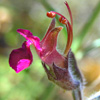Teucrium divaricatum is a perennial herbaceous plant with branching, upright stems up to 30 cm in height. The stems, calyx, and underside of the leaves are whitish and covered with long, white hairs (villous). The upper side of the leaves is glabrous, and dark green. The leaves are rhomboid, petiolate, with a pointed base. The leaf margin opposite the petiole is crenate, or saw-like with rounded teeth. The margins close to the petiole are entire. The leaves are slightly fleshy or leathery (coriaceous). When crushed, they emit a cacao-like scent. The leaves which accompany the flowers (bracts) are ovoid with entire margins.
Teucrium divaricatum flowers in the spring and early summer, from April to July. The petals are fused into a single lower lip, as in all Teucrium species. They are a striking purple or pink/magenta to wine-colored. The flower is relatively large, with a calyx of 8 mm and a corolla up to 20 mm in length. The middle lobe of the lower lip of the corolla extends downward and is concave. The petals are slightly hairy, and the sepals are very hairy. The stamens and pistil are long and arched, and they extend above the lower lip of the corolla.
Teucrium divaricatum is found in batha and garigue habitats, mostly in the mountains of the Mediterranean region. It thrives on Terra Rosa soil, while other Teucrium species prefer marl or rendzina soils.
The plant is used as a herb to make tea of many uses in folk-medicine. It is particularly used for treatment of colds: to reduce fever, and for coughs, sore throats, and hoarseness.
Its global distribution is in countries along the Eastern Mediterranean shore.
The genus ‘Teucrium’ is characterized by a flower whose corolla is composed mainly of a single, lower lip (palate). More precisely, the upper lip of the corolla (hood) is reduced so that it is very short, almost missing. The lower lip of the corolla is divided into five lobes: the central one is large and concave, and the others are elongated. The flowers have 4 stamens, unequal in length, which extend out of the corolla. The stigma is divided into two branches of almost equal length. The flower is pollinated by bees. The calyx is campanulate or tubular, with 10 veins and a 5-lobed margin. The Hebrew name is derived from the Arabic word for ‘curly’, because of the wavy margins of the leaves of the Teucrium capitatum plant. The Latin name refers to King Teucer of Troy, who supposedly recognized the medicinal properties of the plant. The genus includes 300 species worldwide, 11 of which are found in Israel, and of these, 2 are annuals, 5 are herbaceous perennials, 4 are sub-shrubs. Most of the Teucrium species are found in Israel in Mediterranean habitats.
Written by Mike Livne







